
Vanquish meets 575M Ferrari 575 vs. Aston Vanquish. Two giants of the manual super-GT era collide. The final hurrah. The Vanquish is both the last of the trad Astons and the first of the modern era, while the 575M is the last of Ferrari’s great manual GTs. Time for them to go head-to-head. Words Richard Meaden. Photography Gus Gregory.
Is there a more seductive recipe than the front-engined V12 GT? More practical and less showy than a mid-engined supercar, yet more exotic and enthralling than a fast luxury saloon, this suave, silken breed has captured the essence of four-wheeled wanderlust for more than half a century.
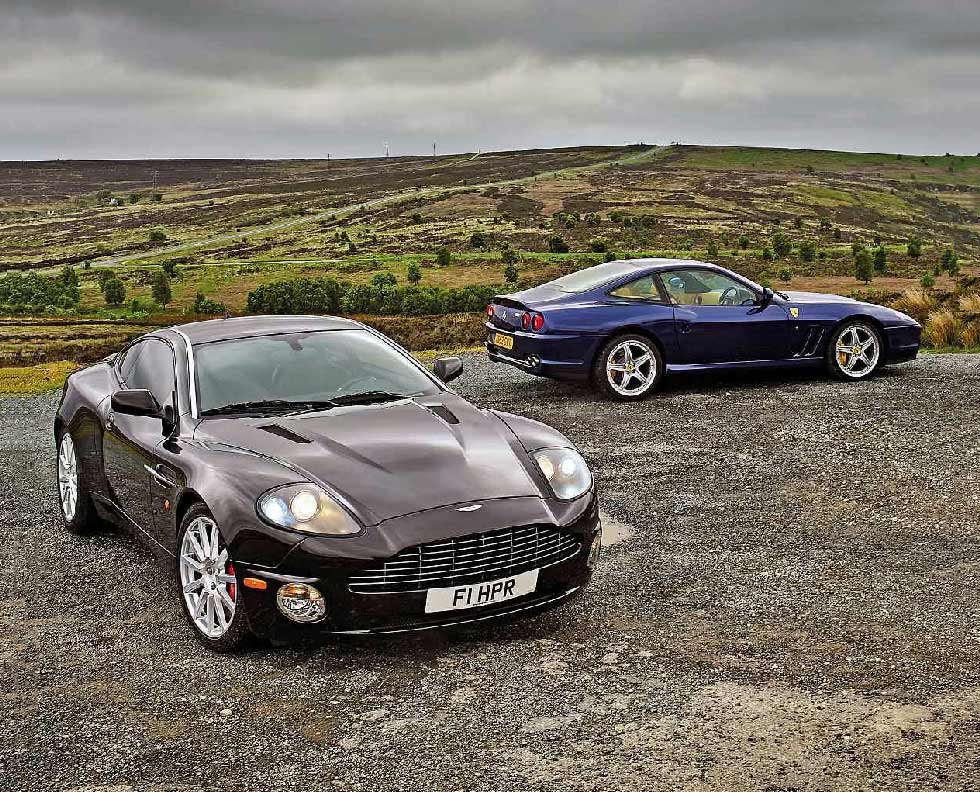
Of those created in the post-millennial era, Ferrari’s 575M and Aston Martin’s Vanquish S are the high watermark: modern classics that combine potency, refinement and presence with perfectly pitched usability and understatement.
Both were bitter rivals in their prime, yet the route by which each came to be is quite different. As successor to the 550 Maranello, the 575 built upon Ferrari’s rekindling of the front-engined formula by offering subtly evolved styling, a useful increase in performance from a modestly enlarged engine and – for the first time in a V12 Ferrari – the option of a six-speed, single-clutch ‘F1’ paddleshift transmission first seen in the F355.
Not surprisingly, of the 2000 or so 575Ms built, the vast majority were ordered with the new transmission, which makes stick-shift 575Ms rare indeed. Quite how rare is apparent when you investigate build numbers: only 249 manual cars were built in total, and only 69 of those were right-hand drive. That makes the car featured here more unicorn than Prancing Horse, and goes some way to explaining why the market has switched on to them in a big way, with values now exceeding £250,000 and the very best commanding considerably more than that. To think £65k would have secured a fine example a few years ago…
For Aston Martin the Vanquish was always intended to be an exercise in revolution, not evolution. Brandishing an all-new name, entirely new underpinnings and a bruising new look, the Vanquish and subsequent Vanquish S served as signals of intent that Newport Pagnell was gunning for Maranello with everything it had. As this was an entirely forward-looking model, a manual transmission was never part of the plan, but unfortunately the Automated Sequential Manual (ASM) transmission fitted to the Vanquish was less than perfect, commonly believed to be the weak link in an otherwise brilliant package. It was improved for the Vanquish S, but by 2006 Aston Martin’s Works Service team had developed a manual transmission conversion for those for whom only a stick would do.
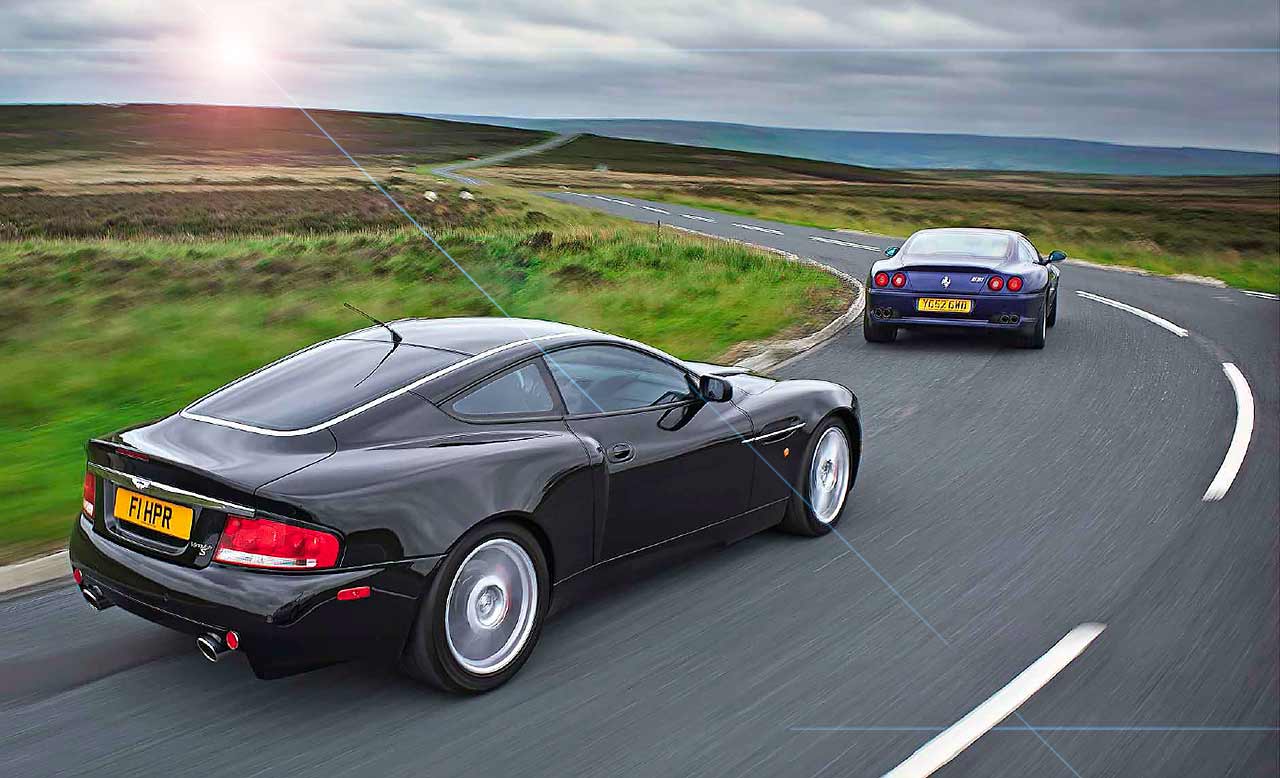
A typically thorough job (not to mention costly – think £20,000), the manual Vanquish rapidly attained cult status for its quirky – some might say eccentric – dedication to the stick-shift cause. Inevitably it also divides opinion in the Aston Martin community, which perhaps explains why values currently seem to sit at the same level, or perhaps even a little below, those for the equivalent factory-standard examples. A combined total of 2589 Vanquish and Vanquish S were built (1503 of the former, 1086 of the latter) but, according to Aston Martin Works (as Works Service is now known), only 75 have been converted to date. No wonder the manual Vanquish is another modern mythical beast.
To glimpse either of these cars is enough to brighten your day. To see the pair together, smug in the knowledge that you’ll be enjoying both in turn on some of England’s finest driving roads, is a special feeling indeed. Both are breathtakingly handsome machines, though to my eyes it’s the Ferrari that has benefited most from the passage of time. Where once that dart-like nose and cyclops air intake challenged the eye, it now looks oh-so-sleek, Pininfarina’s lithe lines flowing uninterrupted along that endless bonnet and into its taut flanks, before culminating in a set of powerfully rounded haunches. The Vanquish’s fuller, muscled physique was always the more readily seductive, Ian Callum’s liquid curves suggesting a more overt sense of potency than any Aston has possessed before or since. It still simmers with the same aggression today, a timeless testament to the power of perfect proportion and stance.
You approach each car with a certain reverence, but it’s the 575M that draws me most insistently towards its driver’s door. Hook a finger under the delicate clamshell latch, wait for the window to drop an inch or two, swing open the weighty door and drop yourself into that beautifully upholstered ‘Daytona’ seat. Instantly you’re immersed in one of the great GT interiors. Intimate yet airy, it blends an inspiringly sporty ambience with genuine drive-all-day luxury. For a car designed to chomp across continents it’s the perfect driving environment.
Anticipation builds as you start the 5.7-litre V12. A short spin of the distinctive-sounding starter motor is all it takes to awaken what is surely one of the great powerplants. There’s no raucous flare of revs, just a gloriously potent murmur as a dozen pistons simmer gently within their cylinders. Depress the weighty clutch, grasp the cold alloy ball and pull it across and forwards to slot first gear. There’s no need for additional revs; you just gently introduce the clutch plates to the flywheel and let the V12 do the rest. Of course, you can pull away with more show, but there’s something delicious about the uniquely elastic performance of such a monumental engine, almost as though because the car has nothing to prove, neither, by association, do you.

There’s a light directness to the 575M’s steering that takes a little getting used to, but once you’ve relaxed into its responses you find a car that’s capable of majestic progress. This particular car has the Fiorano Handling Pack. Comprising red brake calipers with harder Pagid pads, stiffer springs shortened by 15mm, a thicker rear anti-roll bar with firmer bushes and a new ECU for the power steering and electronically controlled dampers, it was offered to address criticism that the 575 lacked the tautness and precision of the 550 it replaced. On the tricky roads that criss-cross the North Yorkshire Moors, it proves its worth, offering plenty of pliancy laced with increased body control. You won’t want to hurl it around like a lightweight sports car, but what the 575 lacks in all-out agility it more than makes up for with towering reach and an intoxicating delivery.
Whether you surf along in sixth or force the issue more emphatically in the lower gears, the 575’s muscle means it can up the pace effortlessly, a squeeze of the throttle squeezing you into the seat with matching insistence. Rarely do you need to extend the V12 beyond its prodigious mid-range but, when you do, the urgency and intensity as it rushes to 7000rpm and beyond is truly breathtaking, though the soundtrack is surprisingly muted.
The great irony in all of this is that having 508bhp and 434lb ft at your disposal means you don’t need to make that many gearchanges. That’s a shame as the 575’s gearbox is a cracker, with a sweet, perfectly weighted, mechanical-feeling shift quality. And, of course, when it comes to manual cars, Ferrari’s iconic open gate is the ultimate: an automotive touchstone that can trace its origins back to the first car to bear The Old Man’s name. If that stuff matters to you, then driving this car feels like a true rite of passage. It’s why, when that spindly ball-topped gearlever was finally phased out, a little of the Maranello machines’ magic was lost forever.

And what magic it is, with each gearshift accompanied by an unmistakable metallic-lack-clack that gives a special kind of aural cadence to every journey. Coupled to strong, feel some brakes and a fine front/mid-engined balance that gives you plenty of confidence, the 575M is a car that rewards finesse but doesn’t demand it. Respect and circumspection are sensible in any rear-wheel-drive car blessed with this level of potency, but it has inherently strong traction and a discreetly effective stability control system that lets you enjoy yourself, then reins things in should conditions or over-exuberance get the better of those ample rear tyres. You can disable the electronic safety net at the flick of a switch, which allows you to discover that the 575 remains exploitable and on your side, right up to and even beyond its limits. However, as befits its maturity and breeding, enjoying the 575 certainly doesn’t rely on smoking the tyres. It’s a class act in every respect.
If the 575M follows Teddy Roosevelt’s advice to ‘speak softly and carry a big stick’, the Vanquish S prefers to hold a megaphone in one hand and wield a 12-gauge shotgun (Purdey, natch) in the other. It’s by far the more extrovert machine in style and character, with concept car looks and a voice from the gods.
As with the 575M, you don’t just walk up to a Vanquish and get in, you admire it and savour how just the thought of driving it makes your heart beat that little bit faster. The interior is in marked contrast to the classic look and feel of the Ferrari. There’s plenty of leather, but there’s plastic, too, not to mention some prosaic switchgear. Yes, the Ferrari makes do with some humble Fiat parts, but it does so more successfully. In years to come the self-consciously millennial look and feel of this new-age Aston will mellow, but at the moment it’s in that awkward aesthetic no-man’s land between contemporary and classic. If I were less fond of the Vanquish I might be blunt and say its interior is dated.
Not that any of this matters when you push the starter button, for if there’s one thing that transcends time it’s the sound of a raucous V12 exploding into life. There’s a serrated, animalistic edge to the Aston’s exhaust note that unfailingly makes you smile. After the initial burst of revs the holler subsides to a pulsing burble at tickover, but it’s always more vocal than the Ferrari.
You sit an inch or two higher than is ideal, but the seat is supportive and cushioned, so you sink into it a little. It’s more immediately comfortable than the Ferrari, if without the same sense of airy spaciousness you get in the 575M. If you’re familiar with the model it’s odd to find a clutch pedal in the footwell and a gearlever protruding from the transmission tunnel, yet the conversion is so well-executed you wouldn’t know the Vanquish wasn’t designed with a stick and three pedals in mind. The only clue is the proximity of the gearknob to the upright face of the centre console, something you’re conscious of when you select first, third or fifth gears.
The shift quality isn’t as precise or mechanical as the Ferrari’s – to be honest, few are – but the weight and throw feel appropriate. Likewise the clutch, which requires meaningful effort to depress, but nothing out of the ordinary. What investment you need to make in terms of physical effort is more than returned by the satisfaction of the added control it brings, not to mention knowing and feeling your connection to the car is that much more intimate and direct.
As with the 575M and 550, the Vanquish S was a measured evolution of the original. Aston Martin effected a suite of improvements, significantly increasing power and torque, enlarging the brakes, tightening the ride and handling and refining the aerodynamics. The result is a car that retains the generosity and warmth of character of the original Vanquish, but which adds welcome poise and pace, plus a much-needed uplift in braking performance.
Aston also worked hard to improve the quality of the ASM paddleshift transmission. It was more incisive when driven in anger and more controlled when executing the kind of low-speed manoeuvres that got the early cars’ clutch plates in a twist, but it still fell short of the best, 575M F1 included. Swapping the sequential manual gearbox for a true stickshift manual has a transformational effect on the Vanquish, though funnily enough it remains the only divisive element.
Fans of the ASM gearbox think it perverse to subject the car to such a ‘retrograde’ modification; for the rest of us, the manual conversion is salvation for an otherwise wonderful car. Naturally enough, the novelty of a manual Vanquish S puts the spotlight on the transmission but, just as with the regular ASM-equipped car, there’s so much more to this Aston than its gearbox. In S-specification the Vanquish really comes alive, largely thanks to the engine modifications (new cylinder heads, fuel injectors and engine mapping) that boost peak power from 460bhp to 520 and torque from 400lb ft to 425. The headline-grabbing result of this increased output is a top speed that just breaches the magic 200mph mark, but the more meaningful and accessible benefits are felt with every squeeze of the throttle.
The S is a sharp and incendiary machine. Point it down a fast, sweeping road and you immediately feel it has the chassis to match, thanks to brake and suspension upgrades that were first made available in the shortlived Sports Dynamic Pack offered on the regular Vanquish for just a few months before they were incorporated into the S model. Driven on the same roads at similar speeds to the 575M, the
Vanquish S feels smaller and more nimble. There’s more of an edge to the ride, but the body control is a fraction tighter. It eggs you on more insistently and wears its heart on its sleeve. Despite the more emotional delivery it remains a grown-up GT, with the kind of comfort and long-legged performance to devour a 500-mile drive with relish. The engine is a more dominant element of the overall driving experience, largely because it’s far more vocal than the hushed Ferrari V12.
A natural showman, the Vanquish S is the most readily exciting and exuberant until you really extend the 575M into the upper reaches of its rev range. In truth there’s very little in it for outright engine output or pace – the Ferrari will hit 100mph in just under 10sec, the Aston a fraction over. As you might expect, it’s the Italian engine that feels smoothest, most cultured and more tractable, though, to be fair, both cars offer a brand of performance that’s totally corrupting.
To explore the abilities of either car is to appreciate the difference between a high-performance version of a mainstream car and truly fast cars bred from noble bloodstock.
As such, the 575M and Works-converted Vanquish S are glorious reminders of a time, not so distant, when the organic component was the one entrusted with making the whole ensemble sing. Of this pair, the Ferrari is the better car, but only just. Swifter and more finely wrought, with a delicious drivetrain and flawless pedigree, it has a deep desirability that’s reflected in skyrocketing values – but the Vanquish, too, is magnificent. Less serene, perhaps, but a more ebullient and expressive character. Its engine lacks aristocratic breeding and its retro-fit gearshift can’t match the precision and occasion of the 575’s glorious open-gate, but there’s no doubting the Aston’s heart or its ability to thrill.
Like listening to music on vinyl instead of MP3 or paying for your favourite printed magazine rather than consuming free content online, driving cars with a manual transmission is a pleasure rooted in the past. Yet as both these cars prove so ably, it also delivers deeper and more tactile fulfilment here in the present. It takes a certain type of person to appreciate that. We won’t see the like of these big beasts again, but being the last of their kind cements their place as special, covetable things. Best of all, they provide those of us who hold such things dear the chance to celebrate the arcane pleasures of stick and pedal. Amen to that.
Thanks to Yorkshire-based specialist Speedmaster for supplying both the 575M and the Vanquish S, www.speedmastercars.com.
Tech and photos
‘LIKE LISTENING TO MUSIC ON VINYL, DRIVING CARS WITH A MANUAL TRANSMISSION IS A PLEASURE ROOTED IN THE PAST’
‘IF THERE’S ONE THING THAT TRANSCENDS TIME IT’S THE SOUND OF A RAUCOUS V12 EXPLODING INTO LIFE’
TECHNICAL DATA FILE SPECIFICATIONS 2002 Ferrari 575M
ENGINE 5748cc V12, DOHC per bank, electronic fuel injection and management
MAX POWER 508bhp @ 7250rpm / DIN
MAX TORQUE 434lb ft @ 5250rpm / DIN
TRANSMISSION Six-speed manual, rear-wheel drive
STEERING Power-assisted rack-and-pinion
SUSPENSION Front and rear: double wishbones, coil springs, adaptive telescopic dampers, anti-roll bar
BRAKES Vented discs
WEIGHT 1730kg
PERFORMANCE Top speed 202mph. 0-60mph 4.25sec
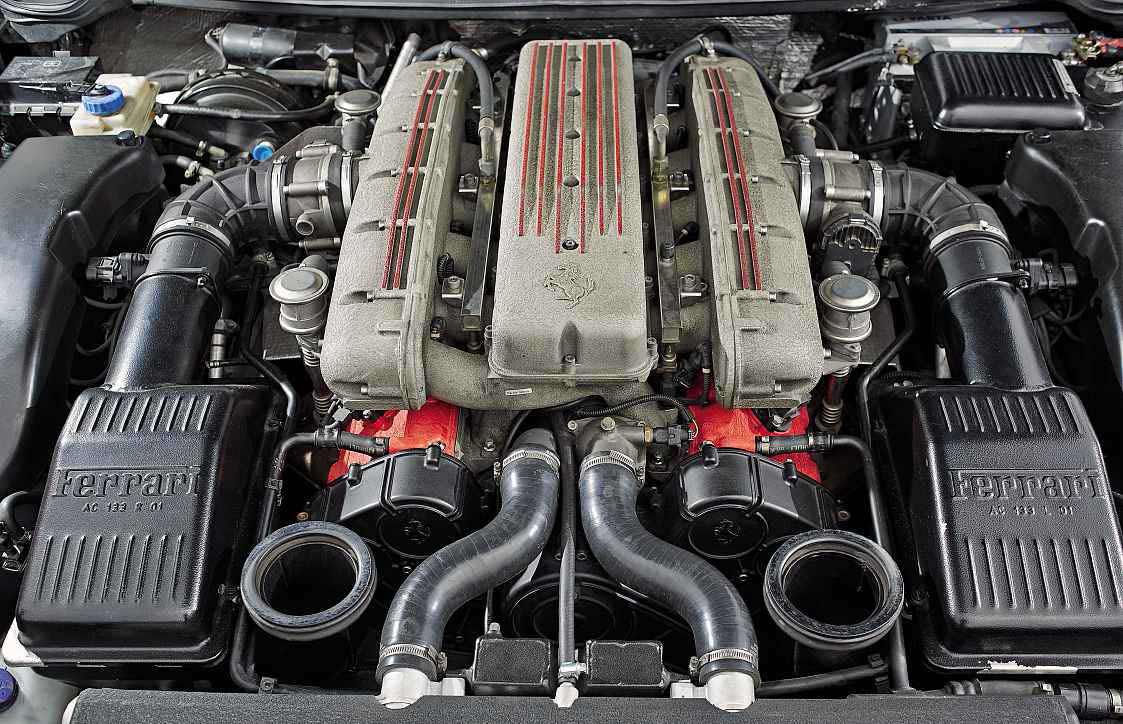
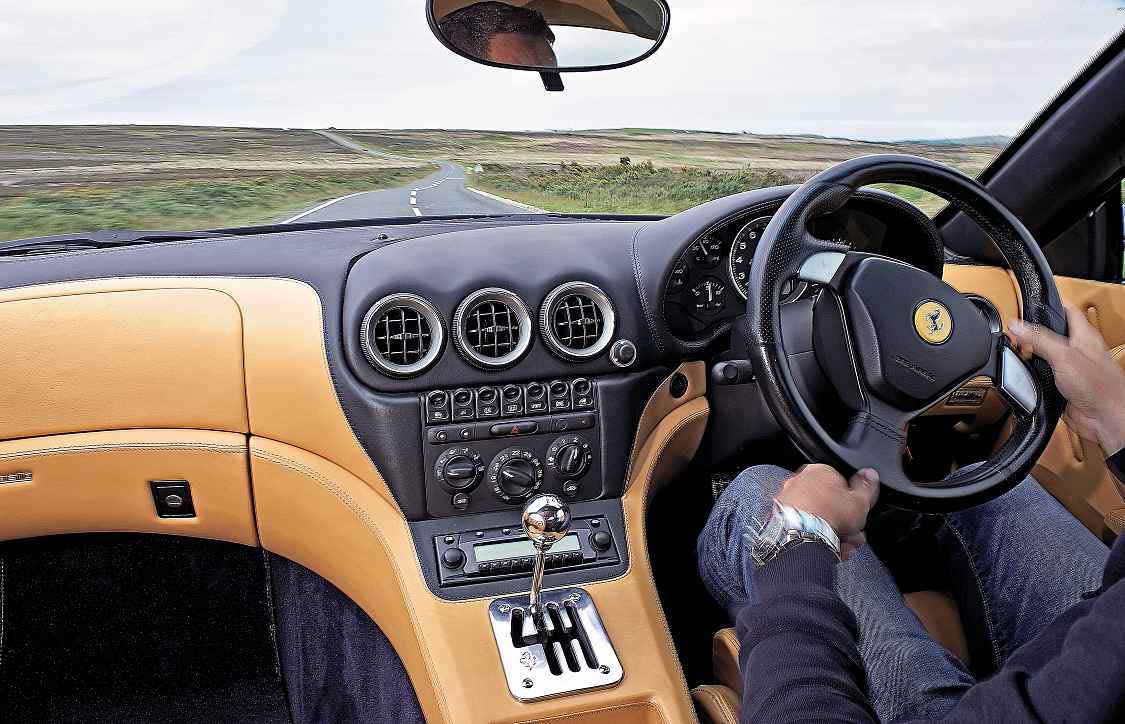
TECHNICAL DATA FILE SPECIFICATIONS 2006 Aston Martin Vanquish S
ENGINE 5935cc V12, DOHC per bank, electronic fuel injection and management
MAX POWER 520bhp @ 7000rpm / DIN
MAX TORQUE 425lb ft @ 5800rpm / DIN
TRANSMISSION Six-speed manual, rear-wheel drive
STEERING Power-assisted rack-and-pinion
SUSPENSION Front and rear: double wishbones, coil springs, telescopic dampers, anti-roll bar
BRAKES Vented discs
WEIGHT 1875kg
PERFORMANCE Top speed 200+mph. 0-60mph 4.8sec
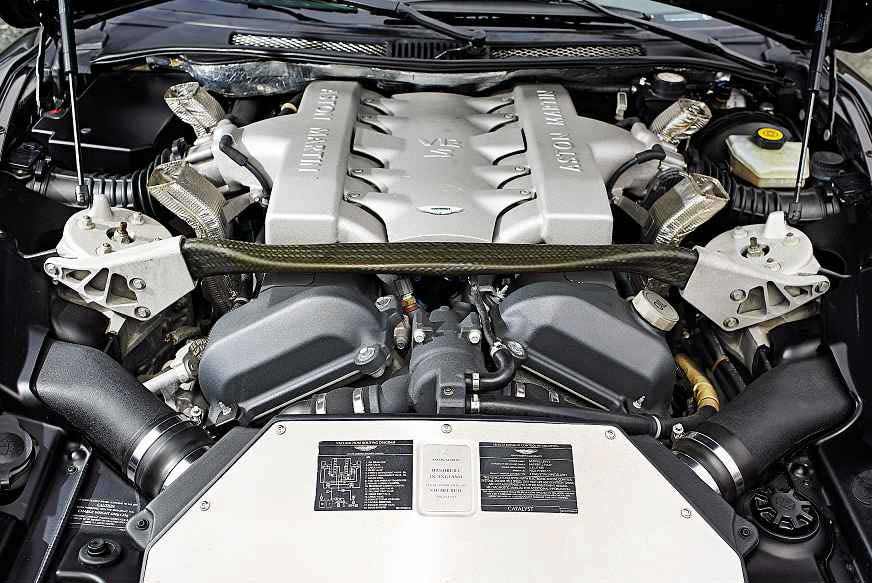
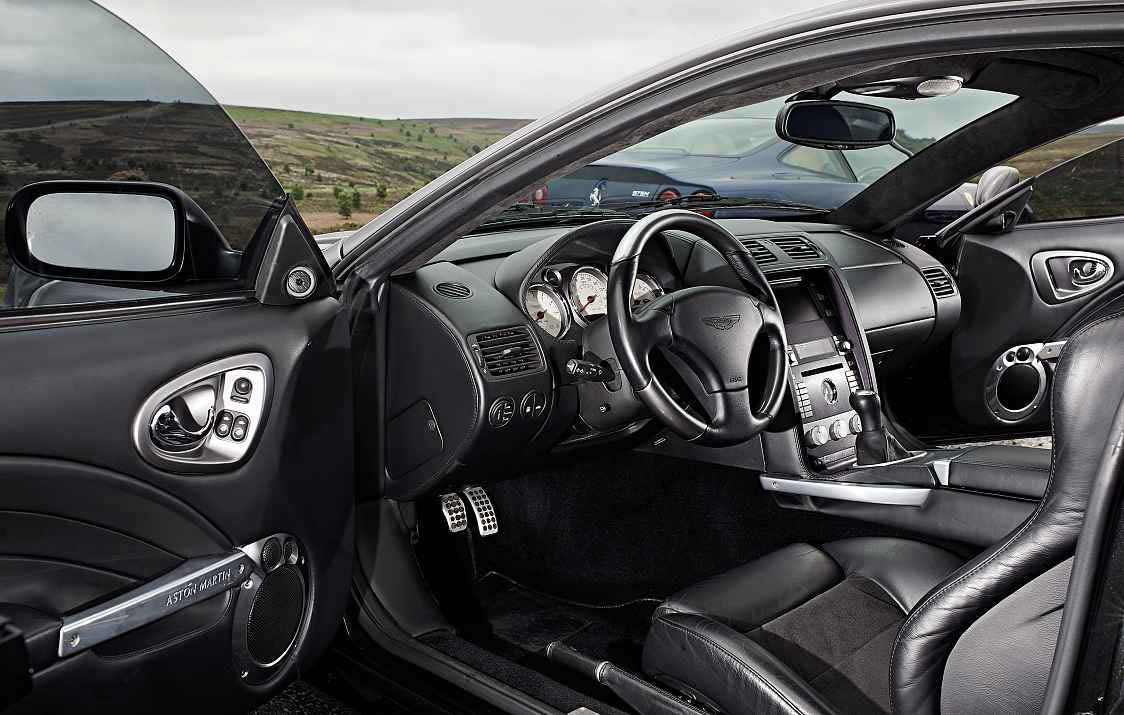
IF YOU CAN’T FIND ONE OF THESE TWO…
If you love the idea of a manual V12 GT but can’t stretch to the evermore expensive 575M and Vanquish S, the Ferrari 550 and Aston DB7 Vantage could well be your salvation.
The earlier 550 Maranello was only available as a manual. There are more of them, too: 3083 cars built, 457 in right-hand drive. Inevitably prices are also on a rapid upward trajectory but, if you’re not afraid of above-average mileage examples, around £80,000 will secure you a lovely one. The best and rarest 550 – the World Speed Record edition – can command three times that.
Like the Vanquish is to Ferrari’s 575M, the DB7 Vantage (pictured far right) was a direct rival for the 550.
The first model to receive Aston Martin’s now-ubiquitous 5.9-litre V12, it boosted the maligned DB7 into the big league. Offered with manual or automatic transmission, the Vantage never quite possessed the pace or class of the 550, but with good manual examples available for around £40,000 it now offers exceptional performance and prestige for the money. The run-out DB7 GT was a last hurrah for the Bloxham era and by far the best series-production DB7. Only 191 were built – 85 for the UK and 64 for the USA – so at £60,000 it’s a great investment for the future.
However, if you’re after the ultimate DB7 then the manual-only DB7 Zagato is your car. It’s stylistically quirky, but the best to drive. Only 99 were built. Expect to pay above £200,000 – if you can find one for sale.





